Ferns can be described as a type of vascular, non-flowering plant, with a range of varieties totaling over 10,000 ferns. These plants can be found in almost any habitat, growing either on land or fully submerged in water.
Ferns can also be seen climbing on trees or growing on trees (as epiphytes), growing partially submerged in water, or even in completely arid conditions (as xerophytes).
Aquatic ferns are one such diversity of ferns. These plants are ideal for freshwater aquariums as they can be grown partially or fully submerged in your aquarium tank.
Coloured in a range of soothing greens, this division of plants will help add a relaxing and natural touch to your aquarium tanks.
Some of the aquatic ferns famed worldwide include Java ferns, the Trident fern, the African Water fern, and even the Windelov fern.
Being simple and easy to attach and care for, these plants make the ideal match for any beginner-level aquarist.
The hardy nature of most ferns allows them to be grown in aquarium tanks with simple environments. This includes tanks with low light, CO2 (carbon dioxide) levels, and also tanks with limited added fertilizer.
Propagating ferns can be done with the help of plantlets on leaves and rhizomes growing at the base of the fern.
Including ferns in your aquarium also bring about a few benefits to its ecosystem.
The main advantage is the absorption of gasses such as CO2, nitrates, and ammonia from the water, acting as a water purifier for your tank fish. They also add oxygen to the water as a by-product of photosynthesis during the day.
Additionally, ferns create many good hiding spots for small fish, fish fry, aquatic snails, and shrimp, away from larger predator fish. This is all excluding the benefit of providing your fish with a completely natural and safe environment that is both pleasant looking and simple and easy for you to maintain.
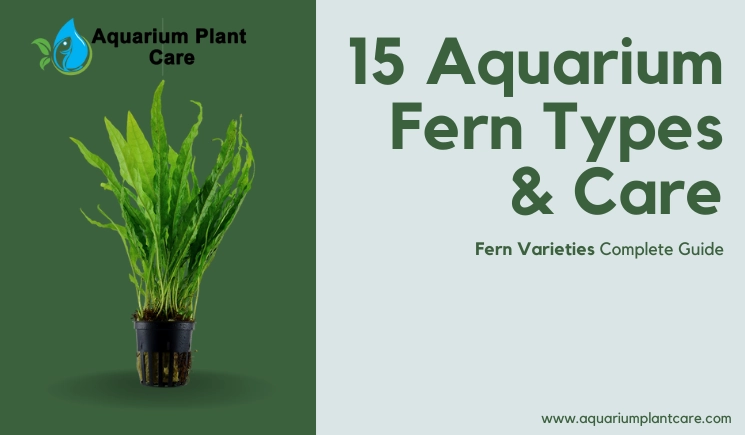
Table of Contents
- History of ferns
- Appearance of Aquarium ferns
- Types and Varieties of Aquarium Ferns
- Java Fern (Leptochilus pteropus)
- Narrow Leaf Java Fern
- Trident Java Fern
- Needle Leaf Java Fern
- Java Fern Windelov
- Fork Leaf Java Fern
- Philippine Java Fern
- Java Fern Fishtail
- Java Fern Black Forest
- Petite Java Fern
- Latifolia Java Fern
- Bolbitis Water Fern / African Water Fern (Bolbitis heudelotii)
- Loma Fern (Lomariopsis cf. lineata)
- Mosquito Fern (Azolla caroliniana)
- Indian Water Fern (Ceratopteris thalictroides)
- Guide for caring for and maintaining aquatic ferns
- Substrate for Ferns
- Lighting Requirements of Ferns
- Water Condition of Ferns
- Common problems of planting Ferns
- Suitable tankmates for Ferns
- Unsuitable Tankmates for Ferns
- FAQs
- Conclusion
History of ferns
Belonging to the Pteridaceae family of the Polypodiopsida class within the kingdom Plantae, ferns have a long recorded history since their presence was first identified nearly 350 million years ago.
Since then, these plants have been known to be growing in shady, rocky crevices, both in and out of aquatic habitats.
Ferns are known to be abundant mainly in geographical regions with a tropical climate.
For instance, the Java fern, faithful to its name, was originally found on the Java Island in Indonesia and is also found in countries such as India, Malaysia, and Thailand. Similarly, a few other types of ferns have been named after the regions, such as Asia and Africa, in which they have been found.
Appearance of Aquarium ferns
Ferns are spore-producing, non-flowering, vascular plants appearing in multiple hues of green. These plants consist of three main parts, namely the leaves, rhizomes, and roots.
The leaves of the ferns come in many different shapes and forms. While some leaves are long, lace-like, and narrow, others are lengthy and wide, or even shapely, in the forms of a trident, or fishtails, thus, giving birth to the names of some varieties.
Growing to an average of 8 to 10 inches, some aquatic ferns such as Java ferns can grow up to heights of even 12 to 13 inches. Selected mature leaves of some aquatic ferns will then grow roots, creating new plantlets that can then be grown into new plants.
The stems of ferns, more commonly known as the rhizomes, are usually seen to grow horizontally along the substrate medium such as stones or driftwood in the aquarium tank.
Rhizomes act as one of the reproductive methods through which new ferns can be grown. It’s as simple as making a cut in a rhizome and securing the new cutting to the substrate.
A noteworthy point with regard to rhizomes is that they should not be buried in a substrate such as an aquarium gravel. This will cut off the oxygen supply, killing the fern. It should merely be attached on to an aquarium decoration, such as a rock or piece of driftwood.
Most ferns have roots that are epiphytic, meaning rather than absorbing nutrients from the soil, they attach themselves to a substrate such as a rock or piece of driftwood.
Once the plant is secured to the substrate, the roots then spread out further, absorbing the nutrients from the water in the aquarium tank.
Another special sight in a fern is the spores produced. These spores can be seen distinctly on the underside of the leaves where small spots will be spread out evenly on each leaf. Each spot contains spores that when collected can be used to propagate new fern plants.
Types and Varieties of Aquarium Ferns
Java Fern (Leptochilus pteropus)
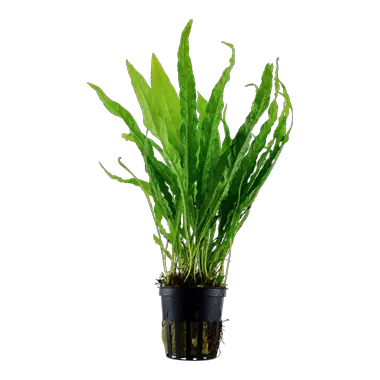
Leptochilus pteropus is a famous, easily recognized, long leafy fern that is best grown either at the rear end or corners of the aquarium tank.
This is owing to its long, thin, dark green hue leaves growing up to nearly 10 to 12 inches in height. With a slow growth rate and the ability to grow in low-lit environments, Java ferns are ideal for tanks with limited CO2 and fertilizer.
They can also be grown either fully or partially submerged in the aquarium tank by attaching to a substrate such as a piece of rock.
Narrow Leaf Java Fern
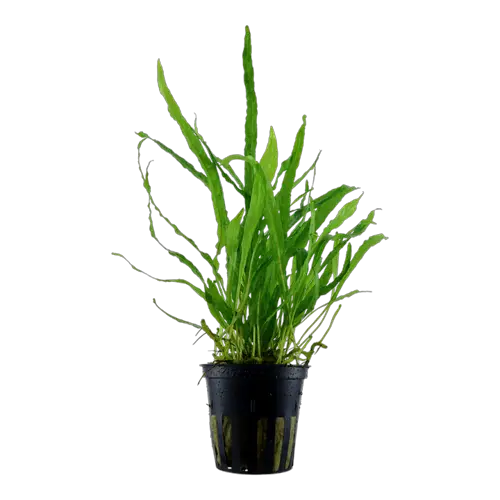
Growing as a cluster of bright green thin long leaf blades, narrow leaf Java ferns provide much required hiding spots for fish fry and other small fish and shrimp.
The leaves of Narrow leaf Java ferns grow nearly 10 inches tall and can be grown either fully or partially submerged in the aquarium.
Trident Java Fern
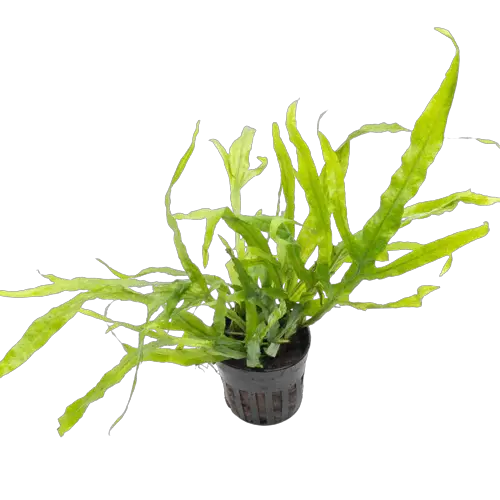
Faithful to its name, Microsorum pteropus, also known as Trident Java ferns, have thin long leaf blades that branch out in the shape of a trident. These ferns grow to a height of about 5 to 8 inches. This height combined with the bright green colour, and bushy growth nature makes Trident Java ferns ideal to be planted in a mid-area of the aquarium, along a rock or driftwood structure.
Needle Leaf Java Fern
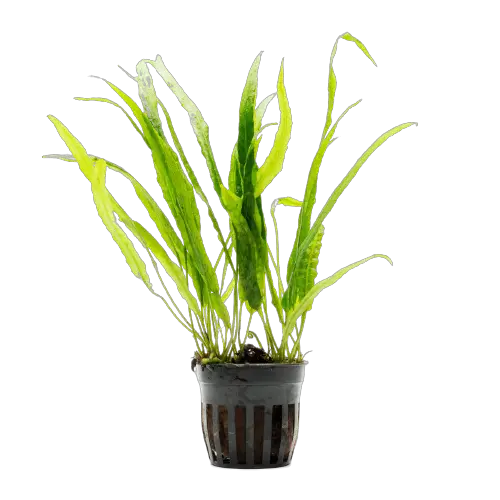
Much like the Trident Java fern in appearance, Needle leaf Java ferns have long thin leaf blades that are bright green in colour. However, the leaves are not branched out in the shape of a trident and instead are only single long blades of leaves.
This fern too grows in a clustered bushy form to heights of nearly 8 inches, and so does well in the rear end of the aquarium tank.
Java Fern Windelov
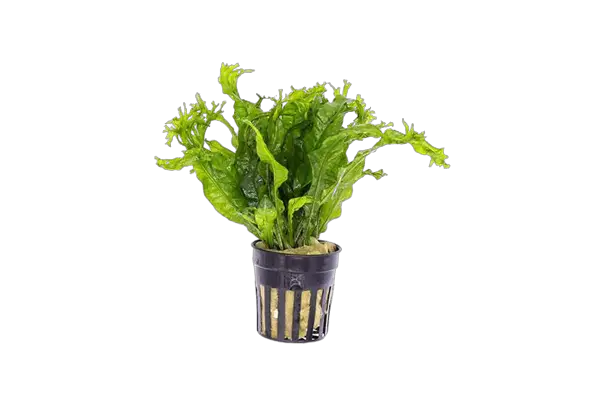
Growing to heights between 5 to 8 inches, Windelov Java ferns can also survive in tanks with low lighting conditions.
These ferns grow in clusters and can be planted in the front or center sections of the aquarium. With moderately dark green leaves these ferns can be identified by their unique leaf shape of being broad and blade-like at the base which then divides into 3 lace-like strands at the very tip.
Fork Leaf Java Fern
This variety of ferns adds in a beautiful contrast to the aquarium with its bright green, fork shaped leaves. Growing in a clustered pattern these ferns look ideal in the mid-ground or background or the aquarium as they grow to heights of 8 to 10 inches.
Philippine Java Fern
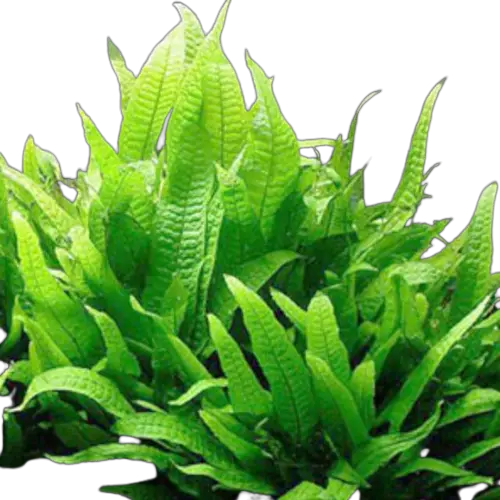
Found in the Philippines, this variety of Java fern has a broad blade leaf structure that has a “hammered” surface pattern. With a bright fresh green hue, the leaves can be seen to grow easily to heights of 10 to 12 inches, looking ideal at the rear end and corners of the aquarium tank.
Java Fern Fishtail
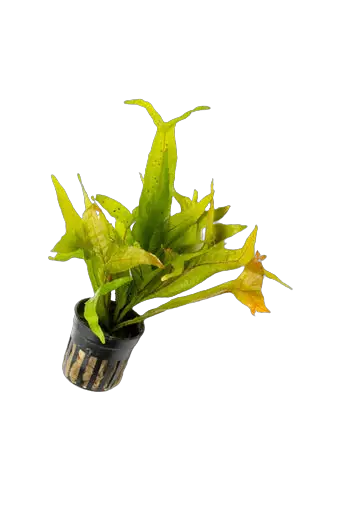
Growing between 7 to 10 inches, the moderately slender leaf blades of this variety of Java fern split in two at the tip, resembling the tail of a fish.
The leaves of the Fishtail Java fern take a pale green colour at the base with the tips looking almost yellowy orange in colour. This variety can be used to add a variation of colour in the mid-ground or back-end of the aquarium.
Java Fern Black Forest
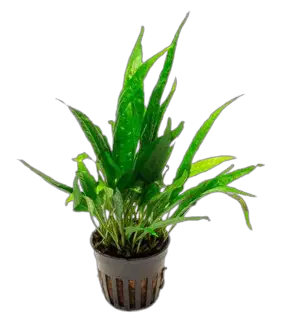
Much like the regular Java fern plant, Black Forest Java ferns have slender, long, and dark green leaf blades with the exception of them being darker and thicker.
Also originating from Indonesia, these plants can grow to a height of 8 inches with ease, thus, being ideal to be planted either in the mid or rear end of the aquarium tank.
Petite Java Fern
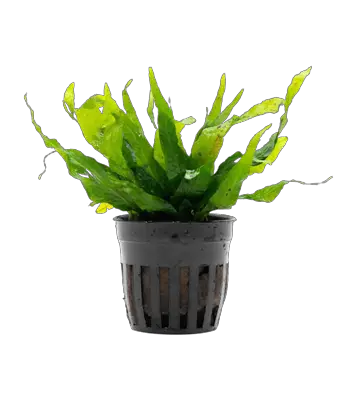
This is simply a more delicate variant of the regular Java fern, ideal for beginner aquarists as it fits well in aquariums of any size. Its small bushy nature is best accented when planted in the mid-ground of the tank.
However, it could be left free-floating in the aquarium as well. Petite Java ferns grow to heights of 4 to 7 inches.
Latifolia Java Fern

With light green leaves and much broader leaves than any other variety of Java fern, Latifolia Java ferns grow to heights of 7 to 11 inches. Its leaves with ruffled looking edges and dark green veins will create a pleasant contrast to any tank Latifolia is added into.
Bolbitis Water Fern / African Water Fern (Bolbitis heudelotii)
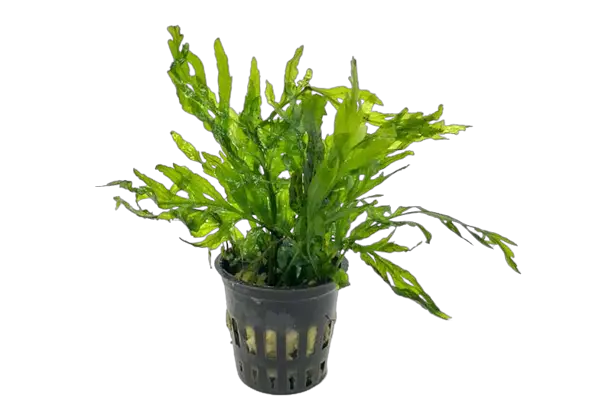
This tropical African water fern is yet another slow-growing plant that is famously included in aquariums. Its nearly transparent leaves are thin and long and can grow between 6 to 11 inches tall.
However, some Bolbitis ferns can also reach up to 15 or 20 inches in height over time. This fern that is also named the Congo fern or Creeping fern, is best situated in the mid-ground of the aquarium, preferably in a region with a moderately high flow of water.
Loma Fern (Lomariopsis cf. lineata)
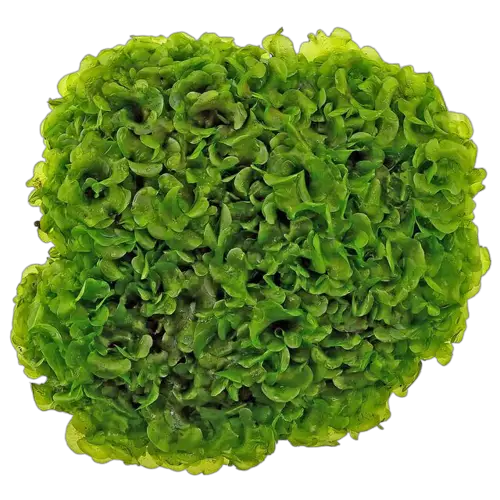
Up until recent years, Loma ferns were categorized as moss or liverwort. This was owing to its huddled moss-like growth nature. Contrasting well with other aquatic ferns and mosses, Loma ferns, also known as ‘Suesswassertang’ (or freshwater seaweed), can be grown to fill in small crevices or as a carpet on the aquarium bed.
Its translucent leaves that are close-knit, rather curvy, and round in shape are rather eye-catching, not only to your shrimp and fish fry that seek shelter from their prey but also to its onlookers.
Mosquito Fern (Azolla caroliniana)
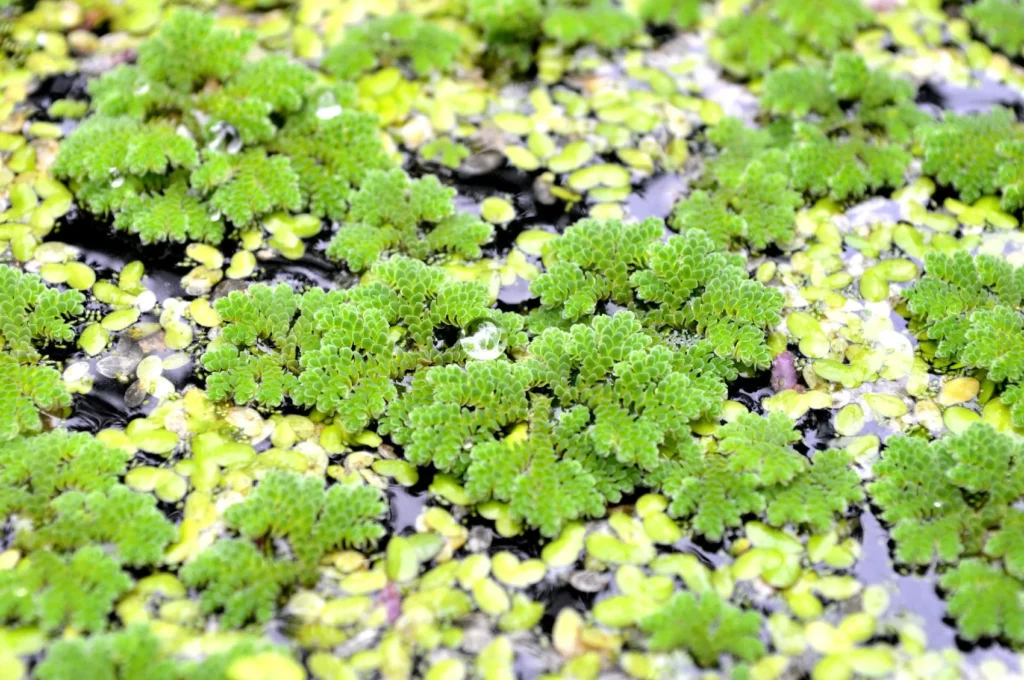
Often less than an inch in length, this 2-leaved fern creates an ideal green top cover over your aquarium, much like duckweed. This fern is much more fast-growing in comparison to other ferns and can double in size within a very short time period.
Indian Water Fern (Ceratopteris thalictroides)
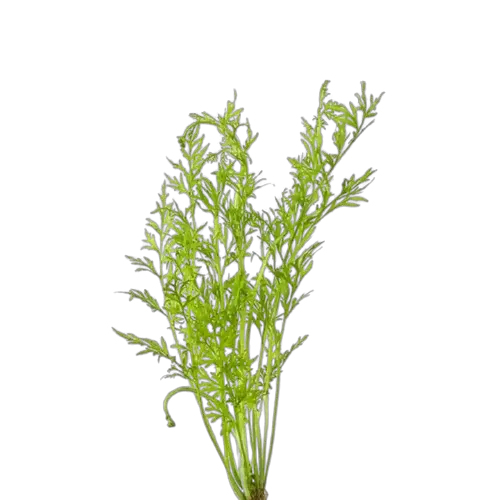
Commonly known as Water Sprite, these ferns require much space to grow. The fast growth rate combined with the ability to grow up to 10 to 12 inches, (and in some instances even taller), make these plants ideal to be grown at the back-end of the aquarium.
Its branched-out thin bright green leaves add in a unique and incomparable beauty to any aquarium that Indian Water ferns are introduced to.
Guide for caring for and maintaining aquatic ferns
Caring for and maintaining aquatic ferns in your aquarium is a straightforward task. Being quite beginner-friendly, these ferns only need a simple touch-up in regular intervals along with some basic requirements of the aquarium water.
During the initial planting stages, it is important to secure the plant by gluing the rhizome to the substrate and ensuring it remains above the gravel layer.
Burying the rhizome in the gravel substrate can cut off the oxygen supply, causing the rhizome to rot, killing your aquatic ferns completely.
Aquatic ferns unlike moss and other aquatic plant varieties don’t necessarily require regular trimming. However, periodically trimming off any overgrowing leaves and dead leaves will help your ferns grow strong while maintaining their luscious look.
This can be done with the help of a pair of sharp scissors and a tweezer to remove the cut leaves from the tank.
Substrate for Ferns
Although aquatic ferns can be planted in your layer of aquarium gravel, it is better to not do so, as burying the rhizome in gravel can cause the rhizome to rot, eventually killing the fern.
However, aquatic ferns can be attached with ease to substrates such as rocks or pieces of driftwood where they thrive very well.
Attaching the fern to the substrate can be done with the help of glue or a piece of string.
If using glue, superglue would be one of the ideal choices in addition to any other aquarium-safe glue that could be bought from any aquarium store. In this instance, all that needs to be done is to apply a few drops of glue to the substrate and firmly press the fern to the rock or piece of driftwood.
Do note to only glue the rhizome to the substrate. Since the glue dries fast, the plant can be introduced into the aquarium without much delay. Any leftover patches of dried glue will be covered up as the fern grows.
An alternative to gluing the fern is to tie the fern to the substrate using a piece of string. This will hold the fern in place until the roots grow and attach themselves to the substrate.
However, the downside of attaching with a piece of string is that the fish may bite on or even get caught at any lengthy or loose ends. This could harm the fish by causing tearing or any sicknesses due to ingesting the string.
Additionally, if the rock or piece of driftwood you have has any wedges or crevices, the fern cutting can be stuck in securely within such a crevice.
Although, there is a possibility of the fern being tugged out by a fish trying to nibble on the plant for food at the early stages.
Lighting Requirements of Ferns
Though ferns possess the ability to grow in low light conditions, ensure your aquarium is kept illuminated with lighting periods between 6 to 10 hours. However, exceeding lighting periods of 10 to 12 hours will encourage algae growth and melting of leaves, stunting your ferns’ growth.
Water Condition of Ferns
Although ferns are hardy aquatic plants by nature, maintaining a high quality of water in the tank in addition to pruning is also beneficial in making sure the fern grows in good form.
This can be done by adding liquid fertilizers and liquid CO2 to enhance sturdy plant growth while maintaining pH levels of 6 to 7.5, temperatures between 20 – 30 degrees Celsius, and the alkalinity levels of water at 3 to 4 dKH.
Common problems of planting Ferns
There’s no doubt that a fully natural aquarium is nothing but a wonderful sight for both its owner and the fish it homes. However, maintaining such a tank is not always simple, even if your aquatic plants are those with easy maintenance.
There are a few common problems that concern planting and maintaining natural plants such as ferns in your aquarium.
Ferns can easily spread and conquer the tank if left untended for long time periods (Overcrowding)
Ferns are plants with a considerably slower growth rate. However, if the aquarium has a nutritious environment and the plants are not trimmed and maintained timely, the chances of the ferns spreading out and growing are very high.
This can lead to the aquarium taking the look of a forest while minimizing the space for free movement for the fish inside.
Pollution of water
If not cleaned periodically, fern plants can trap leftover food waste at the base of their leaves.
This excess food will then decompose and rot, polluting the tank water with harmful gasses. Similarly, if the dying leaves of the fern plants are not trimmed off timely, they too will decay, eventually polluting the tank’s water.
Stunted growth
If the aquarium is filled with natural plants when introducing any new fern plants, the ferns’ growth may be stunted. For this, add in a small amount of liquid fertilizer to help promote the growth of the new fern.
Wilting and dying
However carefully looked after an aquarium tank may be, the chances of diseases being spread through any new plant or fish introduced into the tank are present. This will cause the ferns to look wilted or even have dead leaves or leaves with holes in them.
Such wilting and dying can also be seen as a result of deficiencies in nutrition and lighting.
Therefore, add in a few drops of liquid fertilizer and also increase the period of lighting. When making changes in lighting periods, keep in mind to make small changes to identify the ideal lighting period for your aquarium.
Suitable tankmates for Ferns
Ferns survive well in almost any aquarium environment as they are hardy plants. Therefore, they can be included in aquarium tanks with almost any other variety of plants or small fish.
Some compatible tankmates for aquatic ferns include small fish such as Guppies, Mollies, Angel fish, Betta fish, Oto Cat fish, and smaller Tetra’s such as Neon Tetra and Ember Tetra, and other aquatic pets such as shrimp and snails.
Growing ferns in a bushy manner in breeding tanks is also beneficial since they provide many hiding spots for the fish fry, preventing them from preying on much larger fish.
Ferns can also be grown alongside other aquatic plants such as Anubias and other fern varieties. It will simply add more colour and variation to your tank’s aquascape.
Unsuitable Tankmates for Ferns
In general, larger fish, as well as heavy-eating herbivorous fish, do not thrive well in a simple planted aquarium.
They require much space for movement and high food levels on a daily basis and could devour and destroy aquatic plants in the aquarium tank with ease.
Although such fish may not feed on ferns planted in your aquarium, the chances of destruction by nibbling and uprooting the plants are high.
Some such fish to avoid in small, planted aquariums include Silver Dollar fish, larger Tetra varieties, Goldfish, Oscars, Mbuna, and the Common Pleco.
In addition, filling the aquarium tank with multiple varieties of bushy ferns could cause overcrowding of the tank, limiting the free movement of fish.
Therefore, limiting the number of plants and spacing out the aquatic plants is advisable when aqua scaping.
FAQs
Is fern a good beginner plant?
Ferns make a very good beginner plant with much visual appeal, few requirements, and light maintenance.
Its ability to grow in low light and limited CO2 and fertilizer while purifying the aquarium tank by absorbing the harmful gasses such as ammonia and CO2 while giving out oxygen benefits the beginner aquarist by buying them more time to get familiar with the tank maintenance system.
Can I grow different types of ferns together?
Yes! Growing many varieties of ferns together in the same aquarium tank is possible.
However, it should be noted that ferns grow in a bushy manner.
Therefore, in order to prevent your tank from being overcrowded, it is prudent to space out the plants and consider using substrates of many heights along with plant varieties with multiple colour, height, and leaf pattern variations.
This will help minimize the clustered look in your tank while still giving a natural homey feeling.
How do you plant bare roots in a fern?
Aquatic ferns grow well when the roots are directly buried in the top layer of the gravel substrate. However, they can also be planted by attaching to a rock or piece of driftwood using either aquarium-friendly glue such as superglue or pure silicone, or a piece of thread.
If using a thread, keep in mind to secure the knot tight and to cut the ends as short as possible to avoid it tangling in the fish swimming through the ferns.
How long does it take for a fern to attach?
Ferns can be attached to the substrate with ease and quickness.
Once the knot is tied or the glue is dried with the fern securely in place your fern is ready to be introduced into your aquarium.
What is the importance of planting ferns in my aquarium?
Ferns bring many benefits to your aquarium tank. For instance:
– Acts as a natural home for your aquarium fish,
– Purifying the water by absorbing harmful gases such as CO2 (carbon dioxide), ammonia, nitrates, and nitrites from the aquarium water,
– Adding oxygen to the tank water as a by-product of photosynthesis,
– Providing hideouts for small fish, fish fry, shrimp, snails, or any other small aquarium fish,
– Regulates exercise for your fish by promoting continuous swimming through the plants similar to a natural habitat in the wild,
– Absorbing the excess nutrients from any leftover food or fish excretory matter,
– Last, but not least, adds a soothing visual landscape to your aquarium tank.
What is the smallest fern?
Azolla caroliniana, also known as the mosquito fern, is the smallest variety of fern identified thus far. Growing between 0.5 and 1.5 cm, most fully grown ferns of this kind reach diameters of less than 1 inch.
These dull green ferns once introduced into the aquarium will be seen free floating at the top, multiplying at a fast rate, even in a matter of a few days. Each Mosquito fern has 2 leaves opposing each other, similar to Duckweed.
However, the leaves of Mosquito ferns have a ruffled texture at the edges that Duckweed leaves lack.
Floating freely along the slow-flowing water of the aquarium, the mosquito fern (that earned its name by preventing mosquitoes from laying eggs on the surface of the water), will help draw out your shy fish into the open shady areas of your aquarium.
However, growing a dense layer of these 2-leaved mosquito ferns at the top of your aquarium can block light rays from reaching other plants within your aquarium tank.
Conclusion
In conclusion, it is safe to say that aquatic ferns are a very prominent, colourful, and exceptional addition to aquariums around the world.
The simple and easy caring needed along with the slow growth rate allows any aquarist, either beginner or pro level, to maintain their aquarium tank with a minimal amount of effort.
This is all while elevating the beauty, adding a natural green space for your fish, and creating a comfortable sight in your home.
